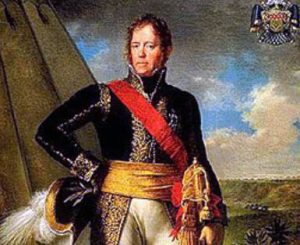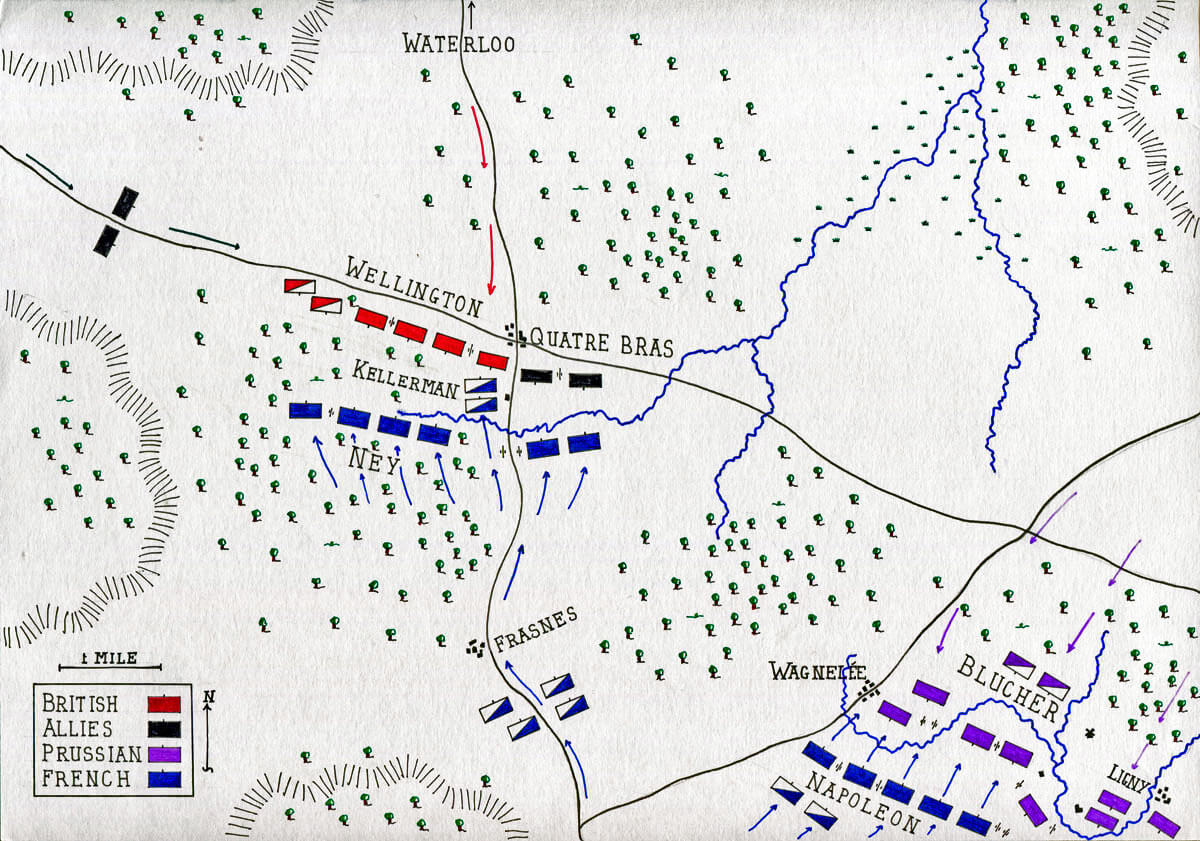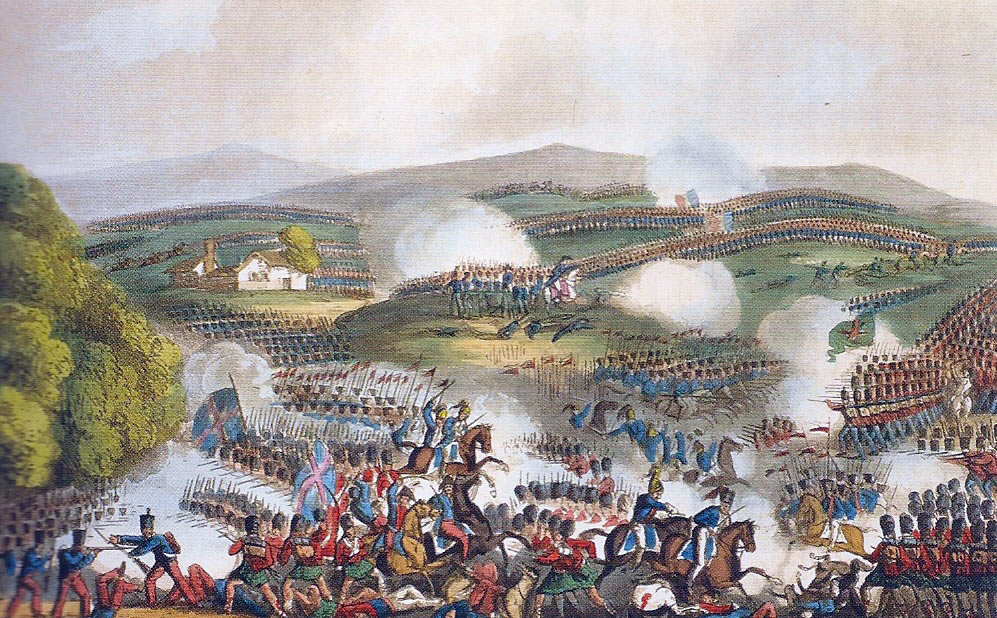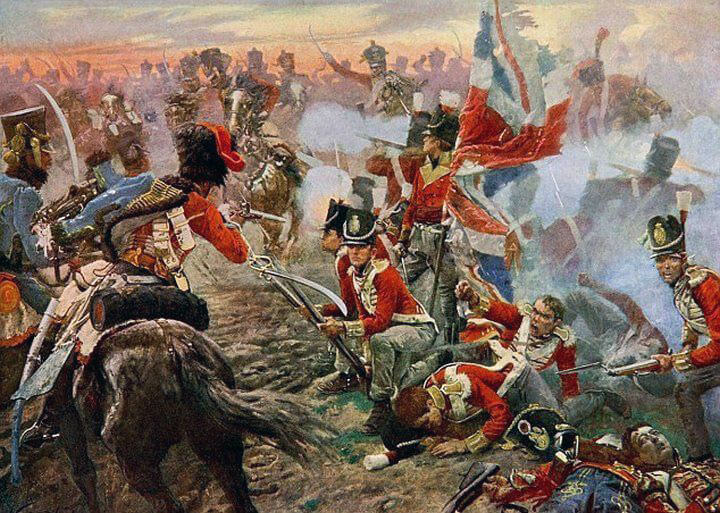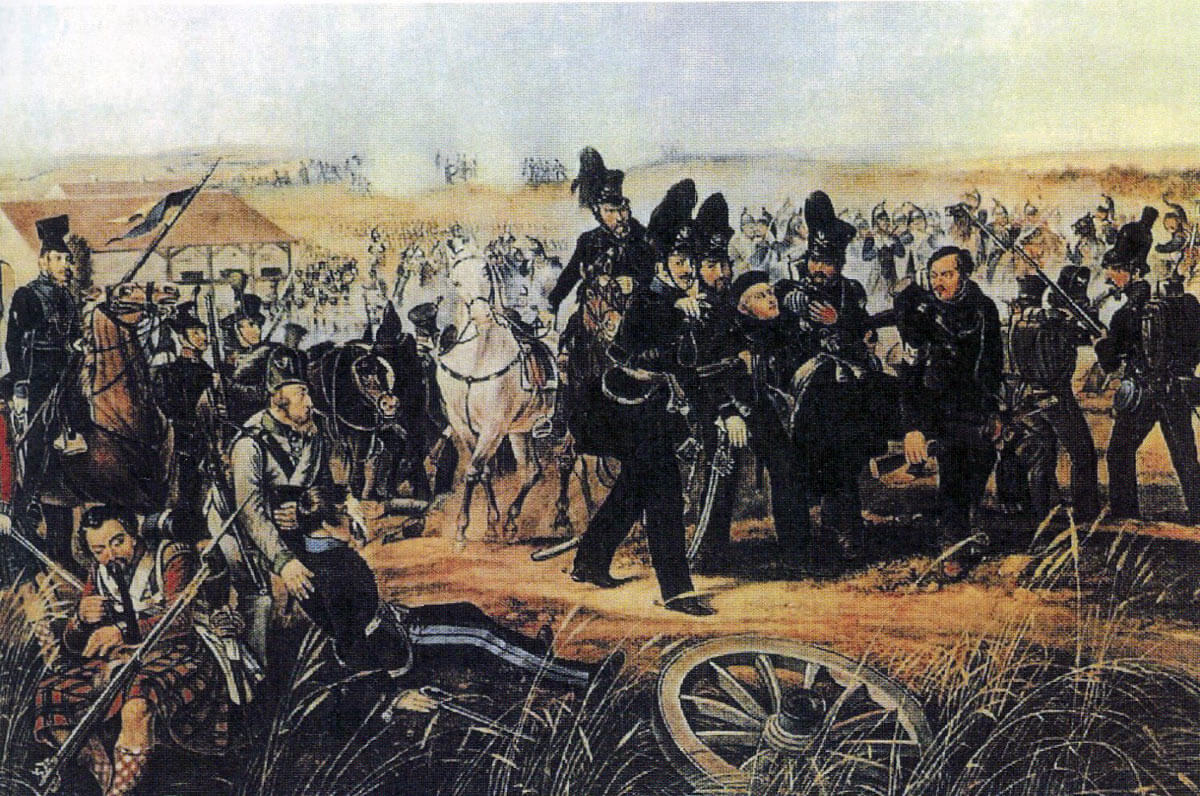Battle of Quatre Bras, with the Battle of Ligny, both fought on 16th June 1815, the two battles preliminary to the Battle of Waterloo
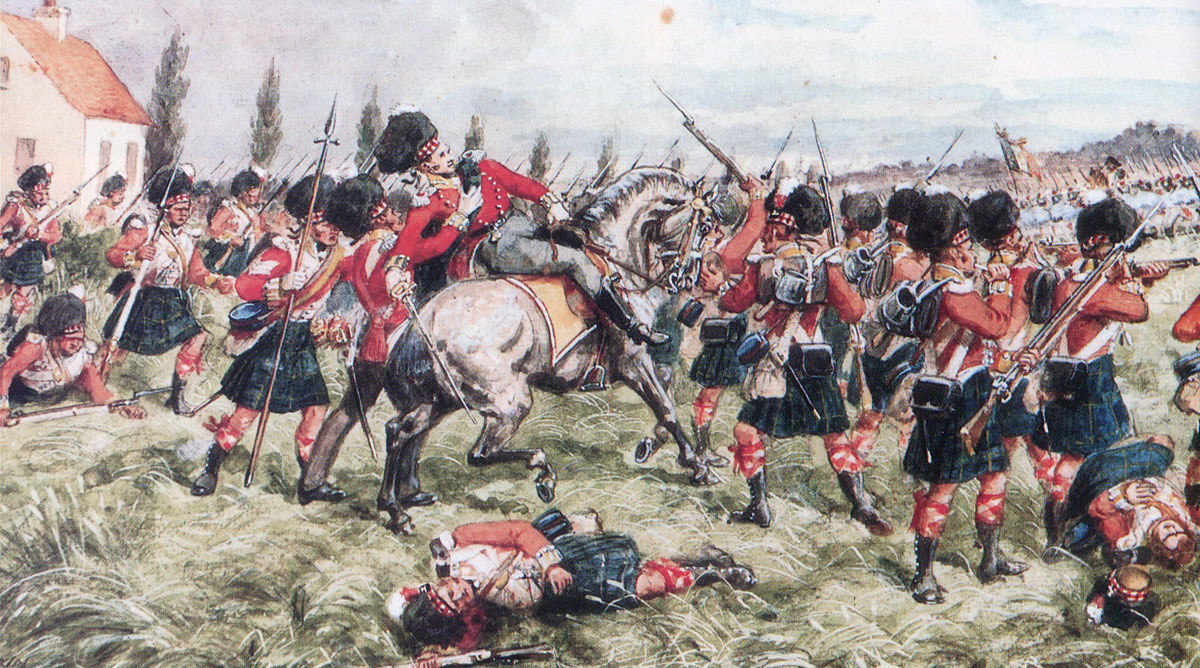
Death of Colonel John Cameron of Fassiefern leading the 92nd Highlanders at the Battle of Quatre Bras on 16th June 1815 during the Napoleonic Wars: picture by Richard Simkin
The previous battle of the Napoleonic Wars is the Battle of Maida
The next battle of the Napoleonic Wars is the Battle of Waterloo
War: Napoleonic: The Waterloo Campaign.
Date of the Battle of Quatre Bras: 16th June 1815
Place of the Battle of Quatre Bras: South of Brussels in modern Belgium at the cross-roads on the Brussels-Namur road.
Combatants at the Battle of Quatre Bras: The allied British-German-Dutch-Belgian army against the French.
Commanders at the Battle of Quatre Bras: the Duke of Wellington commanded the allied force. Marshal Ney commanded the French force.
Size of the armies at the Battle of Quatre Bras: Around 25,000 allied troops against 24,000 French troops.
Uniforms, arms, equipment and training at the Battle of Quatre Bras:
The British infantry wore red waist jackets, grey trousers, and stovepipe shakos. Fusilier regiments wore bearskin caps. The two rifle regiments wore dark green jackets.
British heavy cavalry wore red tunics and roman-style crested helmets. The British light cavalry wore either the light blue of light dragoons or hussar uniforms of shabrach, dolman and busby.
The Royal Horse Guards and Royal Artillery wore blue tunics.
The Royal Horse Artillery wore blue uniforms with the old light dragoon style crested helmet.
Highland regiments wore the kilt with red tunics and tall black ostrich feather caps.
The King’s German Legion (KGL) was the Hanoverian army in exile. The KGL owed its allegiance to King George III of Great Britain, as the Elector of Hanover, and fought with the British army. The KGL comprised both cavalry and infantry regiments. KGL uniforms mirrored the British, as did the regiments of the re-constituted Hanoverian army.

42nd Highlanders Black Watch at the Battle of Quatre Bras on 16th June 1815 during the Napoleonic Wars: picture by Henri Dupray
Belgians and Dutch wore dark blue.
The Brunswickers wore black uniforms.
The French army wore a variety of uniforms. The basic infantry uniform was dark blue.
The French cavalry comprised Cuirassiers, wearing heavy burnished metal breastplates and crested helmets, Dragoons, largely in green, Hussars, in the conventional uniform worn by this arm across Europe, and Chasseurs à Cheval, dressed as hussars.
The Grenadiers of the Guard wore the characteristic tall bearskin that the British Foot Guards were to adopt after the battle.
The French foot artillery wore uniforms similar to the infantry, the horse artillery wore hussar uniforms.
The standard infantry weapon across all the armies was the muzzle-loading musket. The musket could be fired three or four times a minute, throwing a heavy ball inaccurately for a hundred metres or so. Each infantryman carried a bayonet for hand-to-hand fighting, which fitted the muzzle end of his musket.
The British rifle battalions (60th and 95th Rifles) carried the Baker rifle, a more accurate weapon but slower to fire, and a sword bayonet.
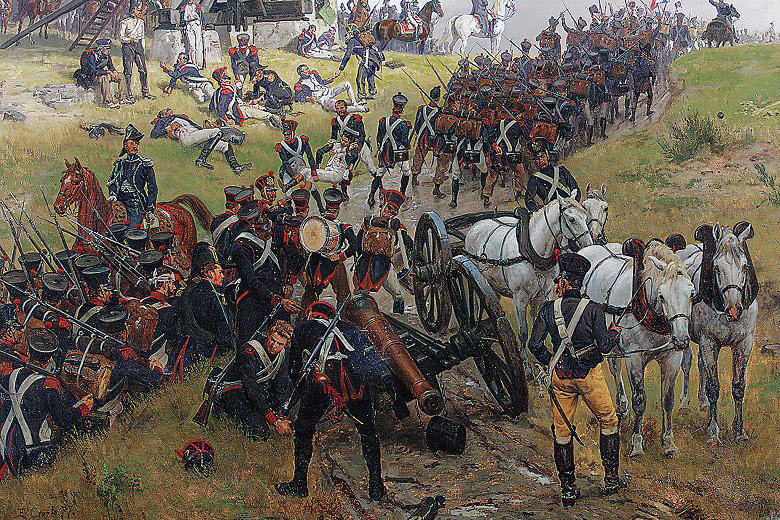
French troops advancing towards Ligny: Battle of Quatre Bras on 16th June 1815: picture by Ernest Crofts
Field guns fired a ball projectile, of limited use against troops in the field unless those troops were closely formed. Guns also fired case shot or canister which fragmented and was highly effective against troops in the field over a short range. Exploding shells fired by howitzers, yet in their infancy. were of particular use against buildings. The British were developing shrapnel (named after the British officer who invented it) which increased the effectiveness of exploding shells against troops in the field, by exploding in the air and showering them with metal fragments.
Throughout the Peninsular War and the Waterloo campaign, the British army was plagued by a shortage of artillery. The Army was sustained by volunteer recruitment and the Royal Artillery was not able to recruit sufficient gunners for its needs.
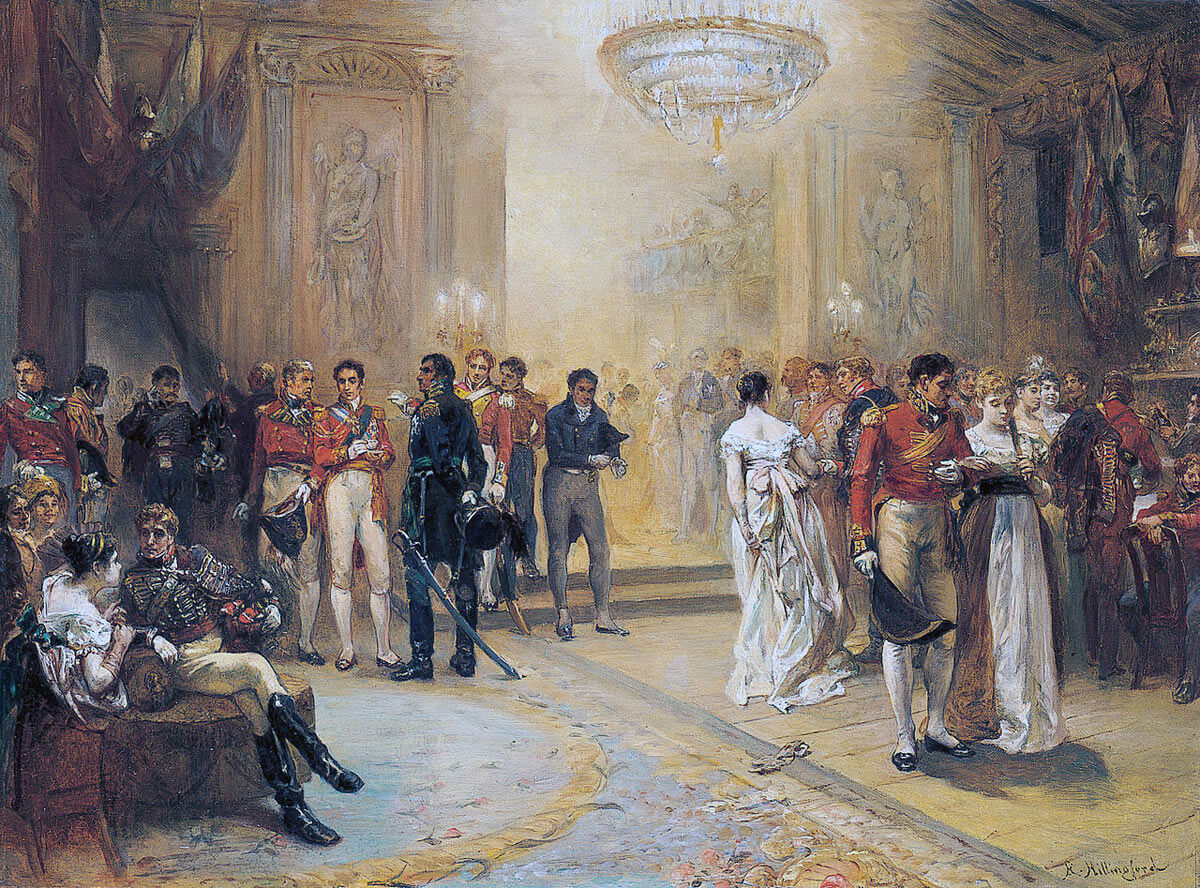
The Duchess of Richmond’s Ball in Brussels on 15th June 1815: picture by Robert Alexander Hillingford
Napoleon exploited the advances in gunnery technology of the last years of the French Ancien Régime, to create his powerful and highly mobile artillery. Many of his battles were won using a combination of the manoeuvrability and fire power of the French guns, with the speed of French columns of infantry, supported by the mass of French cavalry.
Provided the infantry were able to form square, they were largely impervious to cavalry attack, as neither the British nor the French cavalry horses could be brought to ride through an unbroken infantry line and the infantry could not be attacked in flank.
While the French conscript infantry moved about the battle field in fast moving columns, the British trained to fight in line. The Duke of Wellington reduced the number of ranks to two, to extend the line of the British infantry and to exploit fully the firepower of his regiments.
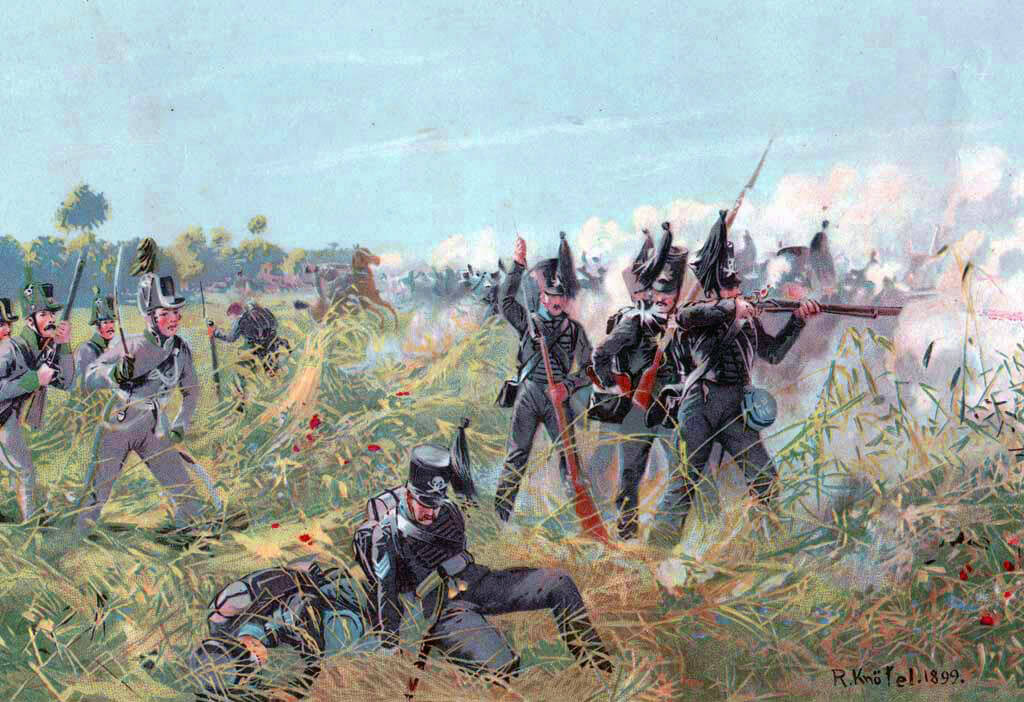
Brunswickers at the Battle of Quatre Bras on 16th June 1815 during the Napoleonic Wars: picture by Richard Knötel
Winner of the Battle of Quatre Bras: Marshal Ney failed to drive the Duke of Wellington off the Quatre Bras cross-roads. However, the Allies were forced to retreat north, up the Brussels road to the village of Waterloo, due to the defeat of the Prussians, under Marshal Blucher, by the Emperor Napoleon in the linked battle of Ligny, a few miles to the south-east of Quatre Bras.
Account of the Battle of Quatre Bras:
On Thursday 15th June 1815, after the Emperor Napoleon’s return from exile on the Island of Elba and the flight of the Bourbon King Louis XVIII, Napoleon crossed the border from France into Belgium with his reconstituted French army, and advanced north.
The Duke of Wellington’s was at his headquarters in Brussels, with his army of British, German, Dutch and Belgian troops cantoned across the countryside. The Prussian army under Marshal Blücher lay to the east.

British officers leaving the Duchess of Richmond’s Ball in the early hours of 16th June 1815 for the Battles of Quatre Bras and Waterloo: picture by Robert Alexander Hillingford
The Duchess of Richmond held a ball in Brussels on the night of 15th June 1815. During the the ball news arrived of Napoleon’s advance. Most of the officers present left to join their regiments and march to meet the French, some fighting the Battle of Quatre Bras without the opportunity to change into field uniform.
The Emperor Napoleon’s plan was to advance in three columns. The centre and right columns would attack the Prussian army, while Marshal Ney, commanding the left column, was to seize the Quatre Bras crossroads, to prevent Wellington coming to Blücher’s assistance. Ney would then attack the Prussians in the rear, completing the destruction of Blücher’s army.
Napoleon expected Ney to occupy the Quatre Bras cross-roads during the afternoon of the 15th June 1815. For some unexplained reason, Ney failed to do so. A squadron of Polish lancers from Ney’s Corps reconnoitred the cross-roads, finding it unoccupied, but withdrew.
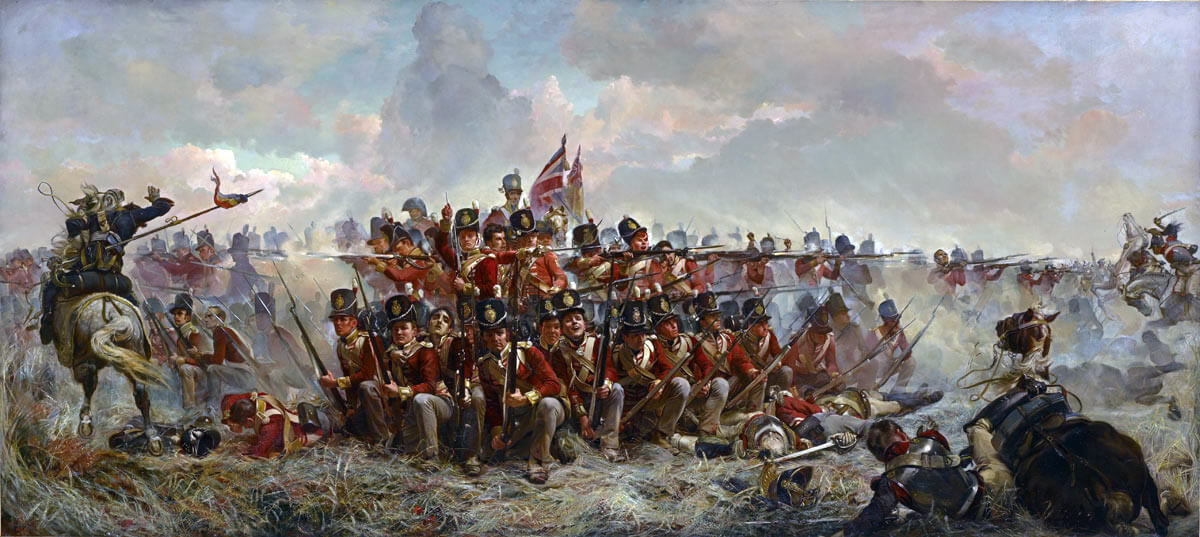
British 28th Regiment receiving French cavalry in square at the Battle of Quatre Bras on 16th June 1815 during the Napoleonic Wars: picture by Lady Butler
Soon after the departure of the Polish lancers, one of Wellington‘s officers, the Prince of Saxe-Weimar, arrived at Quatre Bras with a small force of infantry and guns. Recognising the importance of the cross-roads, Saxe-Weimar remained there.
During the night of 15th June 1815, Napoleon formulated his plan of attack on the Prussian army, which was forming up around Ligny, in Napoleon’s line of advance.
Napoleon re-emphasised to Ney the importance of seizing the Quatre Bras cross-roads without delay the next day.
On the morning of 16th June 1815, the French army began its attack on the Prussian positions around Ligny. If Ney complied with his orders, he would take the cross-roads and launch a devastating attack on the rear of the Prussian right wing at the point when Blücher’s men would be fully committed, dealing with the heavy French frontal assaults.
Despite his instructions, Ney failed to act with urgency and it was not until late morning that he began his move on the cross-roads. By this time, a substantial number of allied units had arrived from the Brussels area.
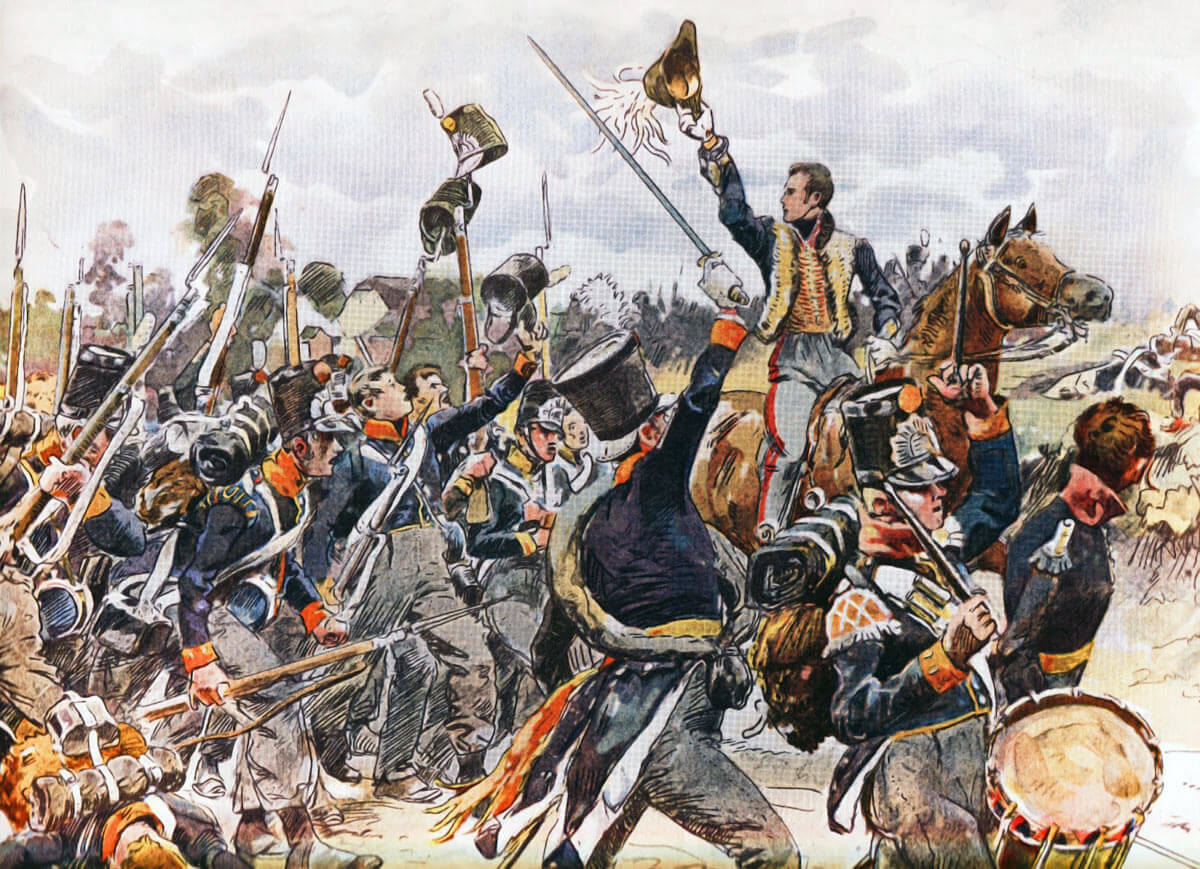
Prince of Orange rallying Dutch Militia at the Battle of Quatre Bras on 16th June 1815 during the Napoleonic Wars
Ney found himself unable to make any headway against the troops holding Quatre Bras. The fighting continued for the rest of the day.
At one point Ney launched a charge by a brigade of Kellerman’s cuirassiers. The British 69th, 30th and 33rd Regiments of Foot were swept aside in the assault, suffering significant casualties, but in turn the French cuirassiers, unsupported, were repelled and retreated in confusion, taking much of Ney’s force with them.
Ney was unable to take Quatre Bras and his failure to attack Blücher’s flank prevented Napoleon from defeating the Prussians conclusively, thereby preventing them from taking any part in the Battle of Waterloo the next day.
In the event, the intervention of Blücher’s army’s was a decisive factor in the Emperor’s final and conclusive defeat at Waterloo.
Casualties at the Battle of Quatre Bras: 4,700 allied casualties against 4,300 French casualties in Ney’s force.
Follow-up to the Battle of Quatre Bras: Two days later the battle of Waterloo was fought on 18th June 1815.
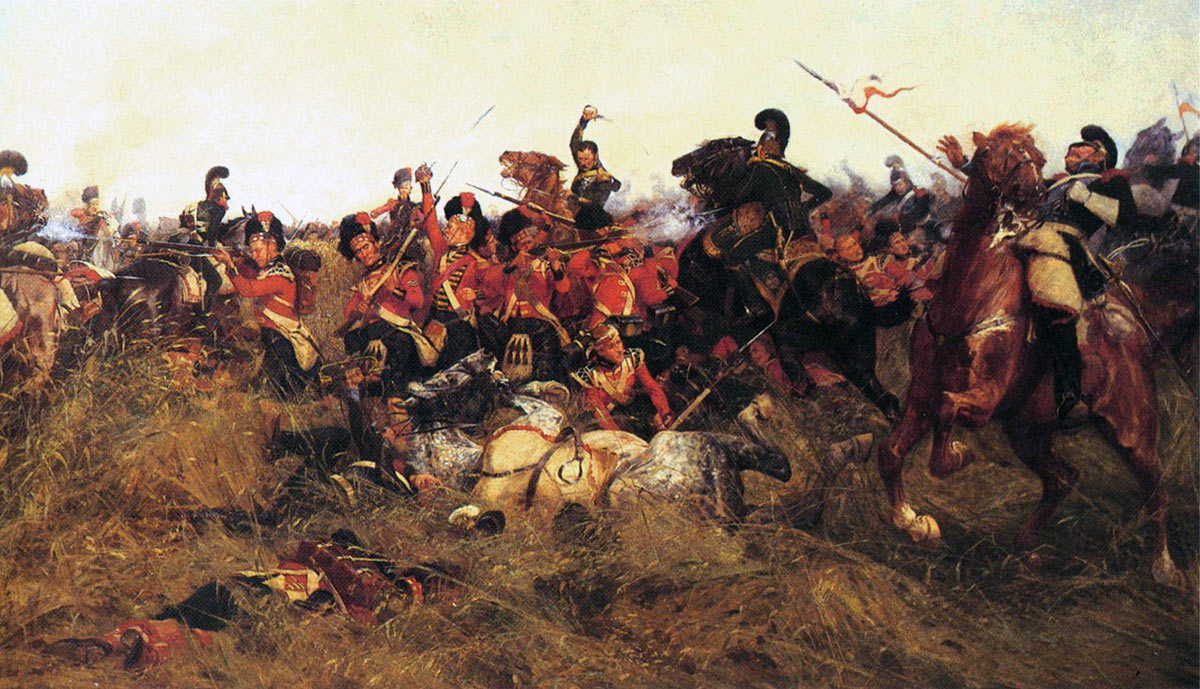
Lieutenant Colonel Sir Robert Macara of the 42nd Black Watch and his men attacked by Polish Lancers at the Battle of Quatre Bras on 16th June 1815 during the Napoleonic Wars: picture by William Barnes Wollen
Anecdotes and traditions from the Battle of Quatre Bras:
- Lieutenant Colonel Sir Robert Macara, commanding the 42nd Black Watch, was severely wounded in a volley from his own regiment fired at the attacking Polish Lancers at the Battle of Quatre Bras. Macara was being carried by a party of his men to safety when they were overwhelmed by lancers and all killed.
- Colonel John Cameron of Fassiefern, mortally wounded leading the 92nd Highlanders at the Battle of Quatre Bras, died the next day. He was buried by the main road, during the heavy rain storm, by his foster brother and his personal servant during his military service, Private Ewen McMillan, and other soldiers from the 92nd. At the request of his family, Cameron’s body was disinterred and brought back to Lochaber in a man-o-war. He was re-buried at Corpach in Inverness-shire. In recognition of his son’s military service, including throughout the Peninsular War, the King made Cameron’s father a baronet.
References for the Battle of Quatre Bras:
History of the British Army by John Fortescue Volume 10
British Battles on Land and Sea by James Grant Volume 2
Wellington: The Road to the Lion’s Mound 1769-1815 by Daniel Res
A Near Run Thing by David Howarth
Wellington by S.G.P. Ward
The Waterloo Campaign: The German Victory by Peter Hofschröer
The Bloody Fields of Waterloo (account of the medical services at the battle and the circumstances of many individuals in the battle) by M.K.H. Crumplin
A Surgeon Artist at War: The Paintings of Sir Charles Bell by M.K.H. Crumplin and Captain P.H. Starling
The previous battle of the Napoleonic Wars is the Battle of Maida
The next battle of the Napoleonic Wars is the Battle of Waterloo
